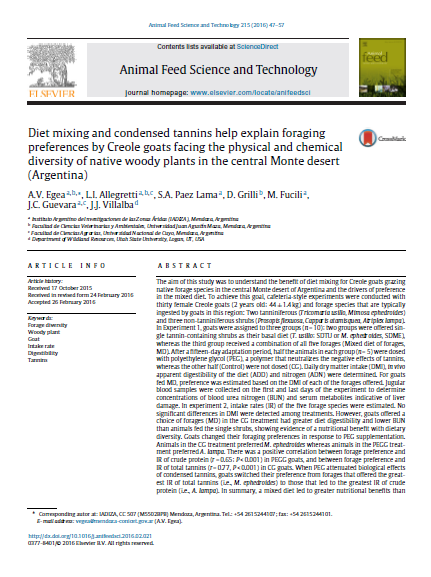Diet mixing and condensed tannins help explain foraging preferences by Creole goats facing the physical and chemical diversity of native woody plants in the central Monte desert (Argentina).
Date
2016-02-26Author
Egea, Angela Vanina
Allegretti, Liliana Inés
Paez Lama, Sebastián Antonio
Grilli, Diego Javier
Fucili, Mercedes
Guevara, Juan Carlos
Villalba, Juan josé
Metadata
Show full item recordAbstract
The aim of this study was to understand the benefit of diet mixing for Creole goats grazingnative forage species in the central Monte desert of Argentina and the drivers of preferencein the mixed diet. To achieve this goal, cafeteria-style experiments were conducted withthirty female Creole goats (2 years old; 44 ± 1.4 kg) and forage species that are typicallyingested by goats in this region: Two tanniniferous (Tricomaria usillo, Mimosa ephedroides)and three non-tanniniferous shrubs (Prosopis flexuosa, Capparis atamisquea, Atriplex lampa).In Experiment 1, goats were assigned to three groups (n = 10); two groups were offered sin-gle tannin-containing shrubs as their basal diet (T. usillo; SDTU or M. ephedroides, SDME),whereas the third group received a combination of all five forages (Mixed diet of forages,MD). After a fifteen-day adaptation period, half the animals in each group (n = 5) were dosedwith polyethylene glycol (PEG), a polymer that neutralizes the negative effects of tannins,whereas the other half (Control) were not dosed (CG). Daily dry matter intake (DMI), in vivoapparent digestibility of the diet (ADD) and nitrogen (ADN) were determined. For goatsfed MD, preference was estimated based on the DMI of each of the forages offered. Jugularblood samples were collected on the first and last days of the experiment to determineconcentrations of blood urea nitrogen (BUN) and serum metabolites indicative of liverdamage. In experiment 2, intake rates (IR) of the five forage species were estimated. Nosignificant differences in DMI were detected among treatments. However, goats offered achoice of forages (MD) in the CG treatment had greater diet digestibility and lower BUNthan animals fed the single shrubs, showing evidence of a nutritional benefit with dietarydiversity. Goats changed their foraging preferences in response to PEG supplementation.Animals in the CG treatment preferred M. ephedroides whereas animals in the PEGG treat-ment preferred A. lampa. There was a positive correlation between forage preference andIR of crude protein (r = 0.65; P < 0.001) in PEGG goats, and between forage preference andIR of total tannins (r = 0.77, P < 0.001) in CG goats. When PEG attenuated biological effectsof condensed tannins, goats switched their preference from forages that offered the great-est IR of total tannins (i.e., M. ephedroides) to those that led to the greatest IR of crudeprotein (i.e., A. lampa). In summary, a mixed diet led to greater nutritional benefits than single diets, which contribute to explain the diverse array of food items goats typicallyshow when browsing in the central Monte desert of Argentina. Our results also show thatCP, tannins and plant structure (which offer variable intake rates) play significant roles ingoats’ foraging preferences in this environment. Fil: Egea, Angela Vanina. Instituto Argentino de Investigaciones de las Zonas Áridas (IADIZA), Mendoza, Argentina Facultad de Ciencias Veterinarias y Ambientales, Universidad Juan Agustín Maza, Mendoza, Argentina. Fil: Allegretti, Liliana Inés. Instituto Argentino de Investigaciones de las Zonas Áridas (IADIZA), Mendoza, Argentina Facultad de Ciencias Veterinarias y Ambientales, Universidad Juan Agustín Maza, Mendoza, Argentina Facultad de Ciencias Agrarias, Universidad Nacional de Cuyo, Mendoza, Argentina. Fil: Paez Lama, Sebastián Antonio. Instituto Argentino de Investigaciones de las Zonas Áridas (IADIZA), Mendoza, Argentina. Fil: Grilli, Diego Javier. Facultad de Ciencias Veterinarias y Ambientales, Universidad Juan Agustín Maza, Mendoza, Argentina. Fil: Fucili, Mercedes. Instituto Argentino de Investigaciones de las Zonas Áridas (IADIZA), Mendoza, Argentina. Fil: Guevara, Juan Carlos. Instituto Argentino de Investigaciones de las Zonas Áridas (IADIZA), Mendoza, Argentina Facultad de Ciencias Agrarias, Universidad Nacional de Cuyo, Mendoza, Argentina. Fil: Villalba, Juan José. Department of Wildland Resources, Utah State University, Logan, UT, USA.
URI
http://repositorio.umaza.edu.ar//handle/00261/1802https://www.sciencedirect.com/science/article/pii/S0377840116300712#!











